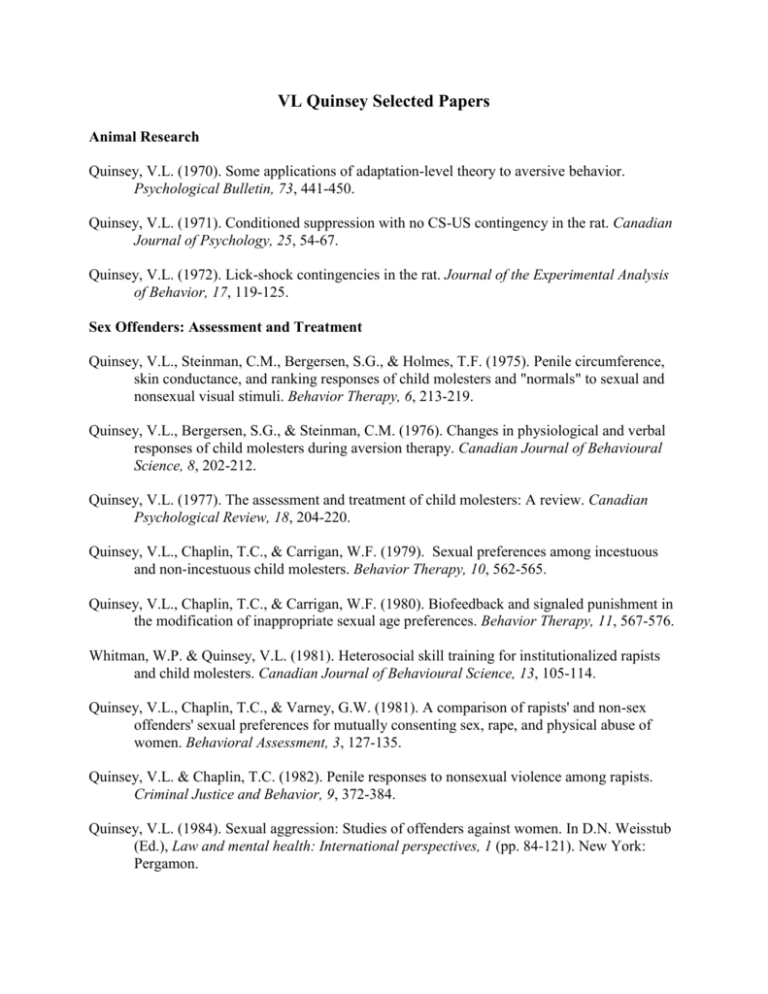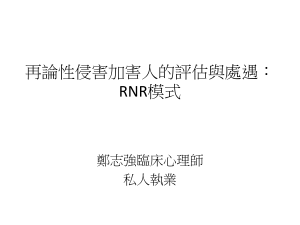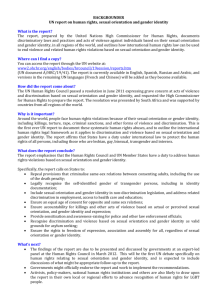Selected Papers
advertisement

VL Quinsey Selected Papers Animal Research Quinsey, V.L. (1970). Some applications of adaptation-level theory to aversive behavior. Psychological Bulletin, 73, 441-450. Quinsey, V.L. (1971). Conditioned suppression with no CS-US contingency in the rat. Canadian Journal of Psychology, 25, 54-67. Quinsey, V.L. (1972). Lick-shock contingencies in the rat. Journal of the Experimental Analysis of Behavior, 17, 119-125. Sex Offenders: Assessment and Treatment Quinsey, V.L., Steinman, C.M., Bergersen, S.G., & Holmes, T.F. (1975). Penile circumference, skin conductance, and ranking responses of child molesters and "normals" to sexual and nonsexual visual stimuli. Behavior Therapy, 6, 213-219. Quinsey, V.L., Bergersen, S.G., & Steinman, C.M. (1976). Changes in physiological and verbal responses of child molesters during aversion therapy. Canadian Journal of Behavioural Science, 8, 202-212. Quinsey, V.L. (1977). The assessment and treatment of child molesters: A review. Canadian Psychological Review, 18, 204-220. Quinsey, V.L., Chaplin, T.C., & Carrigan, W.F. (1979). Sexual preferences among incestuous and non-incestuous child molesters. Behavior Therapy, 10, 562-565. Quinsey, V.L., Chaplin, T.C., & Carrigan, W.F. (1980). Biofeedback and signaled punishment in the modification of inappropriate sexual age preferences. Behavior Therapy, 11, 567-576. Whitman, W.P. & Quinsey, V.L. (1981). Heterosocial skill training for institutionalized rapists and child molesters. Canadian Journal of Behavioural Science, 13, 105-114. Quinsey, V.L., Chaplin, T.C., & Varney, G.W. (1981). A comparison of rapists' and non-sex offenders' sexual preferences for mutually consenting sex, rape, and physical abuse of women. Behavioral Assessment, 3, 127-135. Quinsey, V.L. & Chaplin, T.C. (1982). Penile responses to nonsexual violence among rapists. Criminal Justice and Behavior, 9, 372-384. Quinsey, V.L. (1984). Sexual aggression: Studies of offenders against women. In D.N. Weisstub (Ed.), Law and mental health: International perspectives, 1 (pp. 84-121). New York: Pergamon. 2 Quinsey, V.L. & Chaplin, T.C. (1984). Stimulus control of rapists' and non-sex offenders' sexual arousal. Behavioral Assessment, 6, 169-176. Quinsey, V.L., Chaplin, T.C., & Upfold, D. (1984). Sexual arousal to nonsexual violence and sadomasochistic themes among rapists and non-sex offenders. Journal of Consulting and Clinical Psychology, 52, 651-657. Quinsey, V.L. & Upfold, D. (1985). Rape completion and victim injury as a function of female resistance strategy. Canadian Journal of Behavioural Science, 17, 40-50. Quinsey, V.L. (1986). Men who have sex with children. In D.N. Weisstub (Ed.), Law and mental health: International perspectives, 2, (pp. 140-172). New York: Pergamon. Stermac, L.E. & Quinsey, V.L. (1986). Social competence among rapists. Behavioral Assessment, 8, 171-185. Quinsey, V.L., Chaplin, T.C., Maguire, A.M., & Upfold, D. (1987). The behavioral treatment of rapists and child molesters. In E.K. Morris and C.J. Braukmann (Eds.), Behavioral approaches to crime and delinquency: Application, research, and theory (pp. 363-382). N.Y.: Plenum. Quinsey, V.L. & Chaplin, T.C. (1988). Preventing faking in phallometric assessments of sexual preference. Annals of the New York Academy of Sciences, 528, 49-58. Quinsey, V.L. & Chaplin, T.C. (1988). Penile responses of child molesters and normals to descriptions of encounters with children involving sex and violence. Journal of Interpersonal Violence, 3, 259-274. Rice, M.E., Quinsey, V.L., & Harris, G.T. (1991). Sexual recidivism among child molesters released from a maximum security psychiatric institution. Journal of Consulting and Clinical Psychology, 59, 381-386. Harris, G.T., Rice, M.E., Quinsey, V.L., Chaplin, T.C., & Earls, C. (1992). Maximizing the discriminant validity of phallometric data. Psychological Assessment, 4, 502-511. Lalumière, M.L. & Quinsey, V.L. (1993). The sensitivity of phallometric measures with rapists. Annals of Sex Research, 6, 123-138. Quinsey, V.L., Rice, M.E., Harris, G.T., & Lalumière, M.L. (1993). Assessing treatment efficacy in outcome studies of sex offenders. Journal of Interpersonal Violence, 8, 512-523. Walker, W.D. Rowe, R.C., & Quinsey, V.L. (1993). Authoritarianism and sexual aggression. Journal of Personality and Social Psychology, 65, 1036-1045. 3 Lalumière, M.L. & Quinsey, V.L. (1994). The discriminability of rapists from non-sex offenders using phallometric measures: A meta-analysis. Criminal Justice and Behavior, 21, 150175. Quinsey, V.L., & Lalumière, M.L. (1995). Evolutionary perspectives on sexual offending. Sexual Abuse, 7, 301-315. Harris, G.T., Rice, M.E., Quinsey, V.L., & Chaplin, T.C. (1996). Viewing time as a measure of sexual interest among child molesters and normal heterosexual men. Behaviour Research and Therapy, 34,389-394. Quinsey, V.L., Earls, C., Ketsetzis, M., & Karamanoukian, A. (1996). Viewing time as a measure of sexual interest. Ethology and Sociobiology, 17, 341-354. Lalumière, M. L., Harris, G. T., Quinsey, V. L., & Rice, M. E. (1998). Sexual deviance and number of older brothers among sexual offenders. Sexual Abuse, 10, 5-15. Lalumière, M. L., & Quinsey, V. L. (1998). Pavlovian conditioning of sexual interests in human males. Archives of Sexual Behavior, 27, 241-252. Lieb, R., Quinsey, V.L., & Berliner, L. (1998). Sexual predators and social policy. Crime and Justice: A Review of Research, 23, 43-114. Quinsey, V.L., Khanna, A. & Malcolm, B. (1998). A retrospective evaluation of the Regional Treatment Centre Sex Offender Treatment Program. Journal of Interpersonal Violence, 13, 621-644. Harris, G.T., Rice, M.E., Quinsey, V.L., Lalumière, M.L., Boer, D., & Lang, C. (2003). A multisite comparison of actuarial risk instruments for sex offenders. Psychological Assessment, 15, 413-425. Lalumière, M.L., Quinsey, V.L., Harris, G.T., Rice, M.E., & Trautrimas, C. (2003). Are rapists differentially aroused by coercive sex in phallometric assessments? Annals of the New York Academy of Sciences, 989, 211-224. Quinsey, V.L. (2003). Etiology of anomalous sexual preferences in men. Annals of the New York Academy of Sciences, 989, 105-117. Interventions Quinsey, V.L. & Varney, G.W. (1977). Social skills game: A general method for the modelling and practice of adaptive behaviors. Behavior Therapy, 8, 279-281. Quinsey, V.L. & Maguire, A. (1983). Offenders remanded for a psychiatric examination: Perceived treatability and disposition. International Journal of Law and Psychiatry, 6, 193-205. 4 Quinsey, V.L., Maguire, A., & Varney, G.W. (1983). Assertion and overcontrolled hostility among mentally disordered murderers. Journal of Consulting and Clinical Psychology, 51, 550-556. Quinsey, V.L., Cyr, M., & Lavallee, Y. (1988). Treatment opportunities in a maximum security psychiatric hospital: A problem survey. International Journal of Law and Psychiatry, 11, 179-194. Rice, M.E., Harris, G.T., Quinsey, V.L., & Cyr, M. (1990). Planning treatment programs in secure psychiatric facilities. In D. Weisstub (Ed.), Law and mental health: International perspectives, 5, (pp. 162-230). New York: Pergamon. Rice, M.E., Quinsey, V.L., & Houghton, R. (1990). Predicting treatment outcome and recidivism among patients in a maximum security token economy. Behavioral Sciences and the Law, 8, 313-326. Quinsey, V.L., Reid, K.S., & Stermac, L.E. (1996). Mentally disordered offenders' accounts of their crimes. Criminal Justice and Behavior, 23, 472-489. Quinsey, V.L. (1999). Comment on Fallon, P., et al. Report of the Committee of Inquiry into the Personality Disorder Unit, Ashworth Special Hospital, Vol 1. The Journal of Forensic Psychiatry, 10, 635-648. Institutional Violence Rice, M.E., Helzel, M.F., Varney, G.W., & Quinsey, V.L. (1985). Crisis prevention and intervention training for psychiatric hospital staff. American Journal of Community Psychology, 13, 289-304. Quinsey, V.L. (1990). Aggression research and intervention strategies for the 1990s. In L.D. Presse (Ed.). Proceedings of the Third Symposium on Violence and Aggression. (Pp. 241254). Saskatoon: University of Saskatchewan. Quinsey, V.L. (2000). Institutional violence among the mentally ill. In S. Hodgins (Ed.). Violence among the mentally ill: Effective treatments and management strategies. (pp. 213-235). NATO Science Series. Dordrecht, The Netherlands: Kluwer. Prediction Pruesse, M.G. & Quinsey, V.L. (1977). The dangerousness of patients released from maximum security: A replication. Journal of Psychiatry and Law, 5, 293-299. Quinsey, V.L. & Ambtman, R. (1979). Variables affecting psychiatrists' and teachers' assessments of the dangerousness of mentally ill offenders. Journal of Consulting and Clinical Psychology, 47, 353-362. 5 Quinsey, V.L. (1980). The base rate problem and the prediction of dangerousness: A reappraisal. Journal of Psychiatry and Law, 8, 329-340. Quinsey, V.L. & Cyr, M. (1986). Perceived dangerousness and treatability of offenders: The effects of internal versus external attributions of crime causality. Journal of Interpersonal Violence, 1, 458-471. Quinsey, V.L. & Maguire, A. (1986). Maximum security psychiatric patients: Actuarial and clinical prediction of dangerousness. Journal of Interpersonal Violence, 1, 143-171. Quinsey, V.L. & Walker, W.D. (1992). Dealing with dangerousness: Community risk management strategies with violent offenders. In R. DeV. Peters, R.J. McMahon, & V.L. Quinsey (Eds.). Aggression and violence throughout the lifespan. (pp. 244-260). Newbury Park, CA: Sage. Harris, G.T., Rice, M.E., & Quinsey, V.L. (1993). Violent recidivism of mentally disordered offenders: The development of a statistical prediction instrument. Criminal Justice and Behavior, 20, 315-335. Quinsey, V.L. (1995). The prediction and explanation of criminal violence. International Journal of Law and Psychiatry, 18, 117-127. Quinsey, V.L., Coleman, G., Jones, B. & Altrows, I. (1997). Proximal antecedents of eloping and reoffending among mentally disordered offenders. Journal of Interpersonal Violence, 12, 794-813. Quinsey, V.L., Jones, G.B., Book, A.S., & Barr, K.N. (2006). The dynamic prediction of antisocial behavior among forensic psychiatric patients: A prospective field study. Journal of Interpersonal Violence, 21, 1539-1565. Psychopathy Belmore, M.F. & Quinsey, V.L. (1994). Correlates of psychopathy in a non-institutional sample. Journal of Interpersonal Violence, 9, 339-349. Harris, G.T., Rice, M.E., & Quinsey, V.L. (1994). Psychopathy as a taxon: Evidence that psychopaths are a discrete class. Journal of Consulting and Clinical Psychology, 62, 387397. Quinsey, V.L., Book, A.S., & Lalumière, M.L. (2001). A factor analysis of traits related to individual differences in antisocial behavior. Criminal Justice and Behavior. 28, 522-536. Skilling, T.A., Quinsey, V.L., & Craig, W. (2001). Evidence of a taxon underlying serious antisocial behavior in boys. Criminal Justice and Behavior, 28, 450-470. 6 Skilling, T.A., Harris, G.T., Rice, M.E., & Quinsey, V.L. (2002). Identifying persistently antisocial offenders using the Hare Psychopathy Checklist and the DSM Antisocial personality disorder criteria. Psychological Assessment, 14, 27-38. Barr, K.N. & Quinsey, V.L. (2004). Is psychopathy a pathology or a life strategy? Implications for social policy. In C. Crawford & C. Salmon (Eds.). Evolutionary psychology, public policy, and personal decisions. (Pp. 293-317). Hillsdale, N.J.: Erlbaum. Book, A.S. & Quinsey, V.L. (2004). Psychopaths: Cheaters or warrior-hawks? Personality and Individual Differences, 36, 33-35. Seto, M.C. & Quinsey, V.L. (2005). Toward the future: Translating basic research into prevention and treatment strategies. In C.Patrick (Ed.). Psychopathy Handbook. (pp. 589601). NY: Guilford. Book, A.S., Quinsey, V.L., & Langford, D. (2007). Psychopathy and the perception of affect and vulnerability. Criminal Justice and Behavior, 34, 531-544. Harris, G.T., Rice, M.E., Hilton, N.Z., Lalumière, M.L., & Quinsey, V.L. (2007). Coercive and precocious sexuality as a fundamental aspect of psychopathy. Journal of Personality Disorders, 21, 1-27. Evolutionary Psychology Landolt, M.A., Lalumière, M.L., & Quinsey, V.L. (1995). Sex differences and intra-sex variations in human mating tactics: An evolutionary approach. Ethology and Sociobiology, 16, 3-23. Lalumière, M.L., Chalmers, L.J., Quinsey, V.L., & Seto, M.C. (1996). A test of the mate deprivation hypothesis of sexual coercion. Ethology and Sociobiology, 17, 299-318. Lalumière, M. L., & Quinsey, V. L. (1999). A Darwinian interpretation of individual differences in male propensity for sexual aggression. Jurimetrics, 39, 201-216. Quinsey, V.L., Lalumière, M.L., Querée, M. & McNaughton, J.K. (1999). Perceived crime severity and biological kinship. Human Nature, 10, 399-414. Silverthorne, Z.A. & Quinsey, V.L. (2000). Sexual partner age preferences of homosexual and heterosexual men and women. Archives of Sexual Behavior, 29, 67-76. Quinsey, V.L. (2002). Evolutionary theory and criminal behavior. Legal and Criminological Psychology, 7, 1-13. Volk, A. & Quinsey, V.L. (2002). The influence of infant facial cues on adoption preferences. Human Nature, 13, 437-456. 7 Waller, K.L., Volk, A. & Quinsey, V.L. (2004). The effect of infant fetal alcohol syndrome facial features on adoption preference. Human Nature, 15, 101-119. Provost, M.P., Kosakoski, G., Kormos, C., & Quinsey, V.L. (2006). Female sociosexuality and preference for male masculinization. Archives of Sexual Behavior, 35, 305-312.







